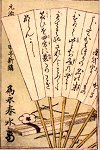
|
|
|
|
|
 |
 |
 |
 |
 |
 |
|
|
|
Trains Run on Time The miniature steam engine that had been presented to the Japanese government at the time of Admiral Perry's arrival in 1853 had made a deep impression. Even before the fall of the Tokugawa Shogunate steam engines had been ordered. The first train route was to be between' Kyoto and Tokyo. But a series of unforeseen difficulties delayed the track laying between the old and new capitals, and Yokohama, which had become the most important trading center, became the terminus of the first railroad. Only four years after ascending the throne in 1868, the nineteen-year-old Meiji Emperor was able to make the first trip by train from Shimbashi Station in Tokyo to Yokohama. The trip at that time took 53 minutes. The inaugural run, however, was made in considerably less time. The British engineer was determined to show how much speed he could get from his engine. The train carrying the Emperor and his entourage arrived in Yokohama before arrangements had been completed to receive them. Instead of congratulations upon his record-breaking trip, the engineer received a severe reprimand. Accounts of early train rides inevitably include anecdotes about passengers. Many, observing the traditional ritual of removing one's shoes when entering a house, left their shoes on the platform when they entered the train and regretfully watched them disappear as the train departed. Other transportation kept pace. Horse-drawn carriages and street cars, bicycles, and the recently invented jinrikisha competed with hand carried palanquins and ancient oxcarts. Traffic was especially heavy in Tokyo on the street called Ginza which became the first cobblestone thoroughfare.
|
